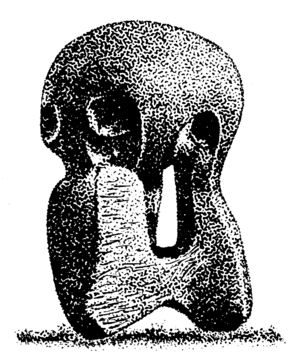Nuclear Energy (sculpture) facts for kids
Quick facts for kids Nuclear Energy |
|
|---|---|
| Artist | Henry Moore |
| Year | 1964–1966 |
| Type | Bronze |
| Dimensions | Divergent measurements exist; see text |
| Location | University of Chicago (outdoor) at the former site of the Stagg Field west stands, Chicago, Illinois |
Nuclear Energy (1964–1966) is a large bronze sculpture created by Henry Moore. You can find it at the University of Chicago in Chicago, Illinois. This special sculpture marks the exact spot where the world's first nuclear reactor, called Chicago Pile-1, was built. On December 2, 1942, a team of scientists made history here. They created the first ever human-made self-sustaining nuclear chain reaction. This was a huge step in understanding and controlling atomic power.
Contents
Where to Find the Sculpture
Nuclear Energy is located on Ellis Avenue in Hyde Park, a neighborhood in Chicago. It sits between the Max Palevsky West dormitory and the Mansueto Library. The sculpture rests on a square concrete platform. This is the exact spot where the Manhattan Project team built their nuclear reactor. They created the first controlled nuclear reaction under the old Stagg Field stands, which are now gone.
The Story Behind the Sculpture
How the Sculpture Was Commissioned
The idea for the sculpture came from the B. F. Ferguson monument fund. In 1973, the artist Henry Moore shared how the project began. He said he had already thought of a similar sculpture idea. Then, Professor McNeill and his team from the University of Chicago visited him. They told him about the important event that happened on their campus.
The Historic Discovery
The team explained that Enrico Fermi, a famous Italian physicist, had achieved the first successful controlled nuclear fission there. This happened in a simple wooden building, like a squash court. It looked very ordinary from the outside. But inside, a secret and incredibly important experiment took place. This successful experiment meant that humans could now control this huge force. It could be used for peaceful purposes, like generating electricity, or for destructive ones.
Marking a Historic Spot
The University of Chicago team felt that such an important historical spot should be marked. They asked Henry Moore if he would create a sculpture for that exact location. Moore's existing idea fit perfectly with their vision.
Size and Dimensions
The Nuclear Energy sculpture has slightly different reported sizes. The Smithsonian Institution says it is about 14 feet (4.3 meters) tall. They also state it is 8 feet (2.4 meters) wide. It sits on a base that is 1.5 feet (0.46 meters) tall and 10 feet (3 meters) wide. However, the University of Chicago states the sculpture is 12 feet (3.7 meters) tall. The Henry Moore Foundation lists its height as 3.66 meters.
Dedication and Recognition
The sculpture was put in place and dedicated on December 2, 1967. This date marked 25 years since Enrico Fermi started the first self-sustaining controlled nuclear reaction. The unveiling happened precisely at 3:36 p.m. The site of this first nuclear reaction has received several important historical honors. It was named a National Historic Landmark on February 18, 1965. It was also one of the first places included in the National Register of Historic Places (NRHP) when it started on October 15, 1966. Later, on October 27, 1971, it became a Chicago Landmark. Four plaques on a nearby granite wall explain the site's history. The oldest plaque was originally placed in 1947. The others mark the sculpture's installation and the site's historic designations.
Working Model in Japan
A smaller version, or working model, of Nuclear Energy exists. It is called "Atom Piece (Working Model for Nuclear Energy) 1964–65." You can see it on display at the Hiroshima City Museum of Contemporary Art in Japan.
Meanings and Ideas Behind the Sculpture
Inspirations for the Design
Henry Moore drew inspiration from many sources for Nuclear Energy. He looked at his own earlier sculptures that had similar shapes. He also found ideas in natural objects, like stones.
The Sculpture's Dual Message
Moore explained the shape of the sculpture himself. He said the top part looks like a large mushroom, or a mushroom cloud. It also resembles the top of a skull. But the lower part looks more like an architectural structure, like a cathedral. Moore thought the bottom could represent a protective form, built for people. The top, however, could represent the destructive side of the atom. He hoped that by combining these two ideas, the sculpture would symbolically show the entire event.
Exploring the Atomic Age
Moore's artwork explores the hopes and fears of the Atomic Age. This was a time when people realized the huge power of the atom. The sculpture connects the potential for controlled nuclear power (which can be good) with the danger of a nuclear holocaust (which is destructive). It uses images like a mushroom cloud or a skull to show this danger. These images are supported by pillars that look like a protective cathedral.
Interviews with Moore highlight this dual nature. The top and bottom parts of the sculpture are meant to show both the creative and destructive power of nuclear energy. The University chose an abstract sculpture to emphasize the importance of the events at the site. They wanted to focus on what these events meant for all of humanity, rather than just on the scientist Enrico Fermi.


